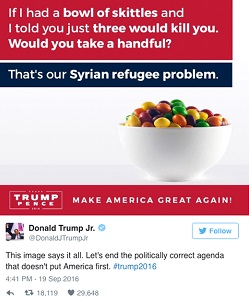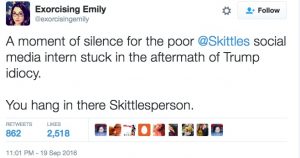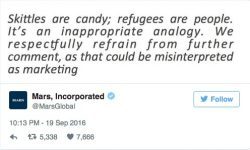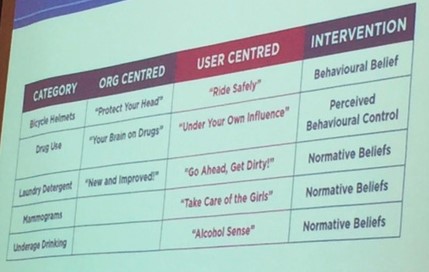With the New Year fast approaching, many of us are already getting ready for the holidays. However, before saying goodbye to 2016 – thankfully! – we at Peak decided to take a look back at what’s taken shape in our industry over the last year. Here is a flashback to some PR breakthroughs that set the stage for 2017.
Changes in the digital world
When acknowledging the benchmarks of 2016, it is difficult to overlook the skyrocketing popularity of Snapchat, or what is now Snap Inc. By launching its Spectacles (sunglasses with a purpose built integrated camera), Snap Inc. ceased being just a social app and became a “camera company”. Snapchat changed the way we shared pictures, now they are changing the way we take them.
Tess Flanders said, “A picture is worth a thousand words” and that idiom has never been more appropriate than it is today. With pictures lasting a maximum of 10 seconds, Snap Inc. is the embodiment of “fast and visual” – a new trend that seems to be catching on. In 2016, the world of news continued its evolution to the visual, but it has also gained velocity. Images are circulating faster as the means of sharing and reposting grows exponentially, meaning opportunities can be squandered more often. Something to keep in mind when creating a new PR campaign in 2017, be ready for snapping!
How to deliver your message
2016 has seen some extremely strong digital campaigns created by both conglomerates and non-profits alike. Disney’s #ShareYourEars, West Jet’s Mini Miracles or 7-Eleven’s Reverse Day are only a few examples of 2016’s successfully carried off digital campaigns. For brands to be relevant, they need to create exclusive content specifically designed for social media; the days of simply repurposing traditional media content are over.
Paid social ads
Increasing use of social media for promotional content is linked to the appearance of another phenomenon that strongly influenced the way PR professionals planned their campaigns in 2016. The digital evolution led to the rise of paid digital and social content, and those efforts are increasingly proving to deliver results. To stay ahead of the pack, PR and communications professionals will have to come up with new strategies to best leverage paid content.
We thought the digital age had already reached its peak several years ago, but technology seems to be as good as its word, and has continued to innovate, challenge and shape the way our industry works and thinks. H.G. Wells said it best, “adapt or perish, now as ever, is nature’s inexorable imperative.”
As we look back at a very interesting year, for the world at large as well as for our industry, we can’t help but wonder what 2017 will bring us. Stay tuned and come back in January to read about our predictions for 2017.
Happy Holidays everyone!
As the world’s knowledge grows exponentially, the challenge to sort through the information clutter gets more difficult. We have been bombarded with fake online news stories that are sometimes difficult to differentiate from legitimate news. A proliferation of fake online stories during the recent USA presidential election made decision making even more difficult for American voters, as they tried finding out the truth about who to vote for. Recently USA Today College posted a story on seven ways to spot fake news stories. It’s an important list that all online news consumers should remember.
Some of the seven ways are obvious but worth repeating. For example, check the date of the news story to make sure that it has not been repackaged or reposted, which is usually an attempt to generate new “clicks” and start the story trending. The original news story may in fact be true and accurate, but repackaged it may be taken out of context and turned into misinformation. Take a look at the publication date as soon as you load the story.
Check the source of the story and find out what other articles they have posted. Does it seem legitimate with a history of good posts or do most of their articles read like a checkout counter tabloid. After that, do a quick Google search and see if any other legitimate news sources are running similar stories. If you can find it on www.cbc.ca or www.cnn.com it’s probably real news. Another simple way to determine if a news story is fake is to do some fact checking and find out the source of any accompanying images. Websites like Snopes, Factcheck.org, and TinEye allow you to compare the information to the facts or determine where images, that often add great credibility to a story, come from.
Finally, don’t get trapped by Clickbait – headlines, stories, articles and images that are so funny, so scary or so frustrating that you feel compelled to read or even re-post. After a minute of reflection, ask yourself if this story is too funny or too scary to really be true.
There are other tools available to check news story sources, but it’s also important to use good common sense and a healthy dose of skepticism about anything you read from an online news source, at least until you are certain it is real and credible.
Every brand both dreams of it and dreads it. It’s the moment the company you represent goes viral and either ‘breaks the Internet’ or just breaks down. Two weeks ago, Skittles was put in this very situation as a result of Donald Trump Junior’s tweet comparing Skittles to Syrian refugees.

It was a Monday and 4:41 P.M. Enter stage right the on-duty social media coordinator for Skittles. Within a matter of hours, Mars’ colourful candy had become the top trending topic on Twitter. All eyes were on Skittles – my own included. What would they do, how long would it take to put together a response, get it approved internally and post it error-free under the pressure. Tweets of support flooded in as PR and social media professionals (and just generally nice people) empathized with the on-duty Skittle social media person, but the clock was ticking…

Skittles had to make a decision – and quickly.
Skittles said what?
Instead of capitalizing on the situation, Skittles smartly stepped back from the situation. Hours later, the brand’s parent company responded from their global handle with:

The response was short, simple, but perfect. It showed that Skittles was totally on top of taking charge of unexpected issues without turning them into reputational crises. While it can be tempting for brands to take full advantage from awkward viral situations, thinking of the bigger picture and how the story will play out is fundamental – especially when it involves politics, religion, disasters or emotive topics.
So what can brands and communicators takeaway from this?
- “Keep responses short, sweet and to the point”, Brian Bell manager brand PR, branded entertainment, and talent at Dr Pepper Snapple Group.
- Don’t overthink and complicate responses
- Avoid getting sucked into providing further commentary once you’ve released your statement
- Don’t self-promote or appear to capitalize on sensitive situations
- Emotion. Mars’ response demonstrated that they were human and not just a faceless corporate brand
Nice work Mars and social media Skittleperson!
Sector experience
Arts and Culture, Non-profit organizations, Corporate
Career background
During university, I worked with multiple student associations on diverse cultural events. After that I was at the Alliance Française of Vancouver, where I worked in a communications and events coordination capacity.
Education
BA in Languages and Literatures and MA in Multilingual Communication from the Université de Louvain, MA in General Management from the Louvain School of Management
Volunteer experience
I currently volunteer for the Canadian Public Relations Society, the Alliance Française and the YMCA on their major annual fundraising event
Favourite part of Peak life
The people and the company’s culture. No matter how stressful work might be, a touch of humour is always present!
If you were to write an autobiography, what would it be called?
The day I decided to move to the other side of the world
Career highlight
While working at the Alliance Française of Vancouver, I organized a conference about Simone de Beauvoir and the history of feminism in France. A few days before the event I received a call from CBC Radio-Canada asking if I would like to be interviewed. The next morning I was in their studio speaking about my conference for the ‘Boulevard du Pacifique’ show.
Favourite B.C. pastime
Rollerblading on the Seawall around Stanley Park
Languages
French, English, Polish, Spanish
Secret Talent
Singing terribly, I sing so badly that my friends once bought me a ‘dislike’ stamp
Furthest flung place you’ve lived?
Brussels, Galway, Madrid, Warsaw, pick your favourite!
Random fact
When I was travelling through Ireland, I met a gentleman carrying a big boar (a stuffed animal, not a real one). Marc (the boar) had his own Facebook page with pictures from all the places he has visited. I ended up on his Facebook page as a ‘boar travel companion’
Facebook is often one of the first social platforms a business sets up – and with good reason. Facebook has over 1.59 billion monthly active users as of January 2016, marking a 14 percent increase year on year. Each day, over a billion people log into this channel to review their news feed and messages.
Brands are fully aware of the potential of this platform. In the US specifically, 80 percent of companies have a Facebook page.
What is worth considering is how your Facebook page can be optimized, and whether your business is utilizing all the tricks available. Below are some ideas to make your content work harder for you.
- Add value: The trick to creating great content is producing images, text or videos that your audience values – rather than what you want to ‘sell’. If you sell ice cream for example, have fun with it and create ice cream based recipes, run contests for the quirkiest ice cream flavour or incorporate posts on keeping cool during the summer months. Whatever you post, add value every time to your audience.
- Community-focused: People ‘like’ Facebook pages to feel part of a community – whether that’s supporting a specific cause, interest or business. While you may have other business related objectives for setting up your page (such as increasing web traffic or sales), keep the idea of ‘fostering a community’ in mind. You can enhance the sense of inclusion by facilitating group discussions and responding to comments in an authentic and helpful way.
- Consistency: Posting content sporadically or leaving a Facebook account dormant is a big ‘no no’. People will ‘unlike’ your page when they see it’s not adding value. Create a content calendar and post ideally once a day, minimum, to justify being a worthwhile page to follow.
- Facebook Insights: Facebook has a great tool called ‘Insights’ that provides an overview of how much engagement your posts are generating. As well as tracking the number of followers to your page, take time to look at the insights – paying particular attention to the levels of engagement generated by each of your posts. Facebook Insights also tracks clicks, reactions, comments and shares. Use this to learn what your audience likes and responds well to – and provide more of it.
- Pin that ‘wow’ content: If you have important content that you want to promote over a longer period of time (say a week, rather than a day) or a post that’s receiving an impressive amount of traction, you can ‘pin’ it to the top of the page. This means even when you post your daily content, your ‘pinned’ post will remain in prime position. It’s a neat trick to make important content go further – without creating a new post.
Most of these are content-focused suggestions. What other ways do you recommend for optimizing your business Facebook page?
Tags: content creation, facebook, social media

Chelsea Clinton at the National Democratic Convention 2016
Both of the Presidential candidate’s daughters spoke a week apart at the respective conventions. Both are young and attractive women and mothers. Both spoke with praise about their parents. For both it was the most important speech of their lives and in front of the biggest audience ever.
Chelsea Clinton talked of her mother’s love for service and her great skills and love as a mother and grandmother. In contrast Ivanka Trump’s speech was about her dad’s focus on his business career.
If you were reading the text of each speech, they both supported their parents and described what they are well known for. But that is not how TV works.
Back in 1964 Marshall McLuhan coined the phrase: “The Medium is the Message.” He wrote all about it in his most widely known book, Understanding Media: The Extensions of Man, published in 1964. McLuhan proposes that a medium itself, not the content it carries, should be the focus of study. McLuhan said that a medium affects the society in which it plays a role not only by the content delivered over the medium, but also by the characteristics of the medium itself.

Invanka Trump at the Republican National Convention 2016
So put the content of the speeches aside, and think back on how the ladies presented. One person had a clear advantage and expertise performing on TV. That was Ivanka Trump. She has co-hosted her dad’s national TV show “The Apprentice” and spoke with ease to the thousands in the stadium and the millions tuning in. She was confident, paused when she needed to and looked like she had made dozens of similar speeches before. She definitely has the training and like her dad she knows how to put on a show.
Chelsea Clinton, not so much. Chelsea has made speeches before, but she’s more tentative, not a commanding presence as all. While pleasant, she is not a forceful personality. Subtly, she came across as lacking confidence.
Donald Trump does not have a lot of substance in what he says, but his bombastic, argumentative and dominating presence his taken him to the top of the Republican ticket. None of his competitors work TV the way Trump does.
One of the big knocks on Hillary Clinton is that people don’t know who she is – they don’t know her; therefore they don’t trust her. Even when TV media are friendly to her, the TV medium is not.
Does the top TV performer always win? The Trumps hope so.
Fun to watch.
Did you know: the average Instagram user only sees 30 per cent of their newsfeed? As social media continues to evolve as a business tool, Instagram (conveniently owned by Facebook) is likewise making large strides to adopt the business-minded algorithm that Facebook newsfeeds adopted years back. With this in mind, here’s why the new algorithm is going to affect you and your brand a little more than you think it might:
You’re going to have to try a little harder
Any savvy Instagrammer that you currently follow – businesses and brands included – will be battling it out to be categorized in the aforementioned elite 30 per cent. How do you do this? The answer’s never as straightforward as you’d like, but the bottom line is that you simply need to generate more appealing content so you don’t get buried in the other 70 per cent. ‘Likes’ and comments matter now more than ever.
So how does this affect the once-authentic (and chronological) nature of this image-based platform? Plenty if you ask John Mayer…

Turning post notifications on may not be the answer
If you haven’t been living under a rock the past week, you’ll have definitely come across brands begging their followers to turn post notifications on in light of the new algorithm changes. But, as a business, is this really your best and smartest option?
Asking followers to turn notifications on is a big ask and it puts the pressure on you to deliver. If people start to get flooded with too many notifications, the quick fix is – you guessed it – to turn those notifications off.

The short answer to keeping people engaged with your page is simply to create engaging content that entices people to ‘like’ and comment on. Unfortunately for content creators, this probably means extra brainstorming hours, but if you keep people coming back despite the new algorithms, you’re golden. Just remember: quality > quantity.
The “Golden Age of Advertising” is now
Advertising on social media doesn’t carry the same stigma now that it did when it was first introduced on Facebook, then Twitter. There’s a reason you’re starting to see more sponsored posts on Instagram these days – it pays off.
And, thanks to the new Instagram algorithms, you’re seeing ads from businesses that are deemed interesting and relevant to you based on the people you follow and things you like on Instagram and Facebook.
As a business, considering advertising buys on Instagram isn’t a sign of defeat. It’s a means of generating engagement from an audience that is hand-picked to fit your target market. The ads are also unobtrusive meaning they look just like any other shared image or video. So, while you may be seeing less organic reach in the future, you’ll at least be seeing more lasting engagement.
So, for now, we’re saying goodbye to the chronological Instagram newsfeed users have come to know and love and embracing (or at least trying to) its new algorithms. Above all, keep calm and don’t turn on post notifications…just yet, anyways.
Tags: digital marketing, digital media, Instagram, instagram algorithms, social media
Sector experience
Oil and Gas, Real Estate, Arts and Culture, Technology
Career background
Previously I have worked for various festivals and a museum in a communications capacity, as well as in corporate communications
Education
BA in Communications from the University of Calgary, Public Relations certificate from Simon Fraser University
Volunteer experience
I have volunteered for multiple years with UNICEF, The Calgary International Film Festival and Free the Children on its ‘We Day’ programs
Favourite part of Peak life
Definitely the people, and how open and supportive of an environment Peak is. That and bagel Wednesday!
Career highlight
Creating a speech and presentation with the VP of the Oil Company I used to work for on his keynote at a major conference. It was very exciting to see 800 people give a standing ovation at the end
Favourite B.C. pastime
Hiking, trying new restaurants and biking along the sea wall
Languages
English and French
Furthest flung place you’ve lived?
Dehra Dun, India
Random fact
I once sat next to a nun on the plane and she gave me a piece of Mother Theresa’s dress for helping her translate her documents
Out with the old, in with the new
Looking back on nearly two decades of public relations work following a 30-year career as a news reporter provides an opportunity to reflect on how PR and the media interact in 2016. The new reality for the news media is there are now fewer people employed to do what, in many cases, is much more work.
After a series of buyouts of senior people, The Vancouver Sun and The Province announced earlier this year that they are merging their newsrooms. What does this mean for PR? Less competition and fewer people to cover news.
Television news that once was confined to slots at noon, supper hour and late newscasts is now delivered 24 hours a day in back to back ‘news wheel’ formats that stretch reporters, editors and videographers to new limits.
A new media frontier
The power of the internet continues to grow, with bloggers having as much or more impact than reporters for mainstream media.
So how does this impact the ability of companies, organizations and public relations professionals to get the message out in the media?
Simply put, the media landscape may have changed dramatically but there are more opportunities and channels than ever for publicity.
Everybody is talking about Donald Trump
Love him or hate him, Trump is a publicity machine. He is getting more media attention than anyone else on earth with radio, television, newspapers and social channels featuring what seems to be a play-by-play of Trump’s latest antics in the Republican presidential candidate race.
Getting noticed still makes or breaks reputations, makes the cash register ring and brings people to the door.
And so, getting your message out with ‘earned’ media – otherwise known as public relations – is still one of the best ways to become known. Although the number of reporters may be contracting, newspapers and television are still hungry for content. The number of social channels grows every day. Trade magazines also abound and every industry is supported by at least one that’s looking for stories.
Do-it-yourself
If you can’t get the media to tell your story through positive news coverage, do it yourself. Have videos produced and tell the story of your own company, your product or your services with words and pictures that matter to your brand. Then, feature it on your website.
Do something amazing and put it on the web via Youtube, Vimeo or Instagram. Send this to everyone you know. If your story goes viral, everyone will know what you want to get across and good things can happen.
Tags: donald trump, media relations, new media, Public relations, social media
This year’s BCAMA annual marketing agency panel did not disappoint. Expert speakers from top agencies provided a strong sense of what’s to come this year and created a healthy debate around what’s really going to be some of the key drivers. There was a ton of information relayed to the hundreds of branding and communications professionals in the audience. Here are few of the highlights we took away with us.

Speaker #1: Andrew McCarthy – President, Tribal Worldwide Canada
The theme of Andrew’s presentation was around using content to connect with consumers. Research has recently shown that 71% of consumers who have blocked ads have said they’d consider whitelist advertising if the content was decent. Basically, people hate bad advertising.
So, how do you increase the shareability of your content?
- Relatability – your content must be relevant
- Have a point of view – this will help streamline content and ensure it’s consistent and interesting
- Findability – search rankings are key when it comes to content dissemination
- Mobility – make sure your content is where your audience is hanging out
- Likeability – it’s an obvious one but your audience has to want to genuinely share your content
Snack Time, the milk producers of Western Canada’s cartoon series, was shared as a successful campaign where all the above was put in motion.
Speaker #2 Kelly Stephenson – Director of Strategy, Creature Agency, Seattle
Kelly’s talk centred around the prediction that there will be a rebalance between data and “creative bravery”. Kelly acknowledged the importance of data but cautioned that often marketers can get so caught up in data that the ability to connect with consumers is lost. Her argument around brands not becoming too obsessed with data was effectively summarised when she said, “data looks backwards; insights look forwards.” Marketers need to consider data and use this to create consumer insights in order to produce relevant and creative narratives that will increase the value of the relationship between brand and consumer.
An example used to highlight this argument was REI and its decision to shut up shop for the day on Black Friday and encourage its followers to #optoutside. REI chose to prioritize its shared values with its Millennial audience, putting a short-term need (a lot of revenue on Black Friday) behind the longer-term relationship. It was a smart move as the retailer generated millions of media impressions and a significant amount of content and engagement around #optoutside.
Speaker #3 April Yao – Senior Account Manager, 6S Marketing & Sheng Li Digital
April got up on stage and immediately said she had to disagree with some of Kelly’s points as 6S still uses and responds to data to ensure successful client campaigns that are closely tracked and clearly show ROI. April primarily presented on two topics: retargeting (also known as remarketing) and marketing to the Chinese population. April discussed the virtues of retargeting and dynamic remarketing (getting specific products that someone has already looked at on your brand website in front of the user when they are viewing another site). She said that, if you follow the cost per click (CPC) model, you’ll see the value quickly.
On the Chinese front, April said that approx. 20% of the Vancouver population is Chinese and encouraged the marketers in the room not to forget this growing market which often has high spending power. She talked about some of the equivalent Chinese social sites such as Youku (video), Baidu (search), and Weibo (think Twitter and micro-blogging).
April gave the example of Cirque du Soleil and how they were selling tickets fast in the English-speaking Vancouver community but not in the Chinese community. Through a Weibo contest, creating a Chinese landing page and a retargeting campaign, Cirque saw a significant increase in its ticket sales. Her final point on this community was that ethnic markets shouldn’t be forgotten but they also require their own distinct strategy.
Speaker #4 Dan Scherk – Partner & Creative Director, Traction Creative
Finally, Dan Scherk took to the stage to discuss the importance of brands adopting a user-centric approach in their marketing campaigns. He talked about how social marketing in particular has proven how brands cannot be organization-centric and that they have to prioritize user needs. Using his psychology background, he delved into social marketing behavioural theories and touched upon reasoned action approach, a benchmark for understanding and predicting human behaviour. Dan emphasised the need for marketers to tap into consumers’ beliefs, showing how that would impact attitudes which would in turn formulate intentions and lead onto certain behaviours.
 The last case study of the morning was an interesting one: it was the “Dumb Ways to Die” campaign that was launched by Metro in Melbourne, Victoria. The cartoon campaign series was focused on reducing the number of accidents on its trains. Based on this, it was extremely successful and resulted in a 20% reduction in accidents. The campaign won top industry awards and was hailed a great success by many. But it was viewed as a failure by others. Why? In the real world, the true issue was suicide. So, a successful user-centred approach would have been around suicide prevention. Instead, the brand took an organizational approach and focused on an issue that was not the real problem.
The last case study of the morning was an interesting one: it was the “Dumb Ways to Die” campaign that was launched by Metro in Melbourne, Victoria. The cartoon campaign series was focused on reducing the number of accidents on its trains. Based on this, it was extremely successful and resulted in a 20% reduction in accidents. The campaign won top industry awards and was hailed a great success by many. But it was viewed as a failure by others. Why? In the real world, the true issue was suicide. So, a successful user-centred approach would have been around suicide prevention. Instead, the brand took an organizational approach and focused on an issue that was not the real problem.
Finally, the panel moderator, Claire Booth of Lux Insights, said that, while #FOMO (fear of missing out) was a real thing last year, this year, it’s apparently going to be all about #FOLO (fear of living offline).
Tags: bcama, featured, marketing, media relations, Peak Communicators









